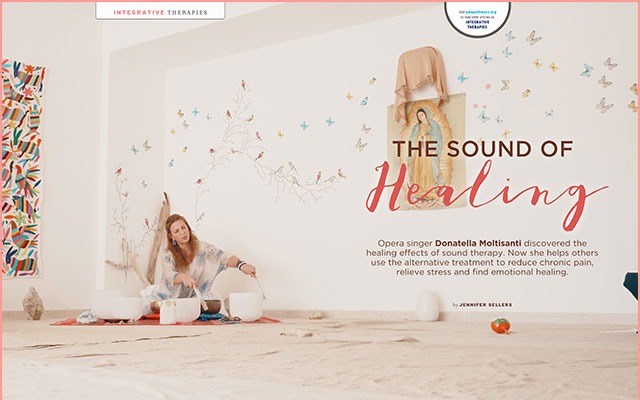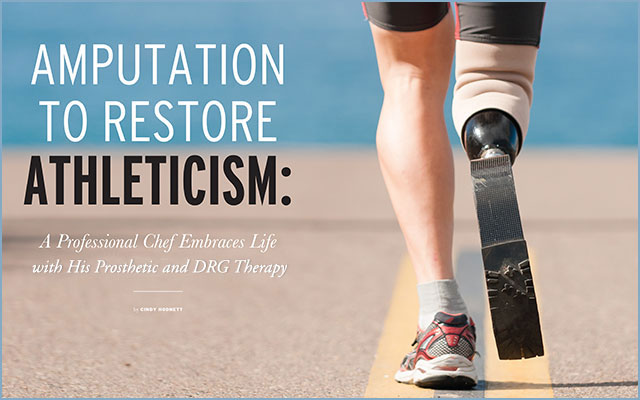Donatella Moltisanti and Sound Therapy

Opera singer Donatella Moltisanti discovered the healing effects of sound therapy. Now she helps others use the alternative treatment to reduce chronic pain, relieve stress and find emotional healing.
When Donatella Moltisanti was 13 years old, she began experiencing excruciating menstrual pain. It was so bad she was incapacitated a full week each month, spending at least two of those days in bed. During those times, there was no relief to be had—no medication would help. To make matters worse, Moltisanti was experiencing undiagnosed thyroid symptoms that wouldn’t be discovered until many years later. It seemed at the time that the young Sicilian was facing a life of chronic pain and fatigue.
But things began changing when Moltisanti started taking voice lessons in her late teens.
“As I was studying singing at the conservatory in Palermo, I started noticing I was having less pain that lasted less time,” she says. “I had been doing so much work with breathing and development of the diaphragm that I was really empowering my body, and I was healing it without knowing.”
Striking a Chord
In music, two or three harmonious notes can be combined simultaneously to create a more distinct, fuller sound. This is known as a chord. When it came to pain, Moltisanti realized that healing also involved multiple elements working in harmony. This happened when she discovered that breathing was only one facet of pain relief. In a sense, she began striking a chord of healing.
When Moltisanti moved to Rome in her 20s, she started working with a voice instructor who taught her vocal techniques that were designed to not only develop and preserve the vocal chords, but to heal the body as well.
“It became about more than just mastering the voice,” says Moltisanti. “My body became an instrument of healing. It was performing work, but it was healing work. It was fascinating to me.”
The more Moltisanti sang, the more she could see that the vibration of the vocal chords was therapeutic. She says the sensation even stimulated her thyroid. “I was becoming less sluggish,” she says.
In addition to breathing and sound vibration, the third note of Moltisanti’s healing chord was the channeling of her emotions.
“To be a performer, you really need to go outside yourself to look for bigger sources of feelings,” she says. “As I delved more into the emotional realm and experienced shifts in consciousness, I began realizing that healing isn’t just on a physical level; it’s also in uncovering what’s going on behind the physical pain.”
Moltisanti describes all of these revelations as her journey to a breakthrough. They transformed how she viewed healing, and they helped her live a more vital, fulfilling life. She says these methods were so successful she has never had to rely on medication over the years. She did, however, encounter new challenges as time went on—challenges that would take her further on her journey.
Healing Takes a New Tone
When Moltisanti went into early menopause in her mid-40s (she’s 54 now), she was hit with an avalanche of symptoms, including chronic pain in her muscles and joints. In addition to the hormonal imbalances she was experiencing related to her menopause, Moltisanti was also diagnosed with Hashimoto’s disease and chronic fatigue syndrome.
RELATED: Lauren Hillenbrand Confronts Chronic Fatigue Syndrome
“I had always relied on my voice and sound work to heal myself, but this pain and exhaustion went beyond the pain of my youth,” she says. “Yet at the clinics I went to, doctors told me they thought I should be even worse. I realized my constant singing was still helping me. I was very sick, but I didn’t have the severe effects I should have had.”
Still, Moltisanti wasn’t seeing much improvement in her current state of health, so she began researching sound therapy again, which led her to experiment with singing bowls. This, she says, began bringing her out of her pain to another level of healing.
“The body remembers traumas it experienced in the past,” says Moltisanti. “When I started using the singing bowls, my body absorbed the sounds on levels I wasn’t even conscious of. With the singing bowls, I could also choose to work in specific chakras and therefore specific organs—the sound penetrated through vibration to those specific places.”
Singing bowls are based in ancient Eastern meditation practices. They typically contain groupings of different-sized inverted bells, each emitting different prolonged tones when struck with a bell mallet. The singing bowls are usually labeled as “Tibetan,” “Himalayan” or “Japanese,” depending on what regional tradition they’re modeled after.
Over time, Moltisanti got more and more precise with her sound work. “After seeing the power of singing bowls, the next step for me was to develop more attunement,” she says. “I was working with pure sound and learning to identify tones that are blind spots for the ear but not for the brain. For instance, there’s a whole world of sound between [musical notes] D and D#.”
Moltisanti’s experience with the singing bowls was transformative. Not only did she see improvement in her pain and hormone disorders, but she found the practice changed the way she performed as well. She began incorporating crystal singing bowls into her performances, along with the unique vocal tones that she had been developing for years.
Many who attended Moltisanti’s performances reported that they experienced soothing, healing sensations from being exposed to the sounds she created. This furthered Moltisanti’s passion for sound work. Not only could she continue her true love of singing and improve her own health in the process, she could also use her talent and vast knowledge of sound healing to help others.
“I was thinking: ‘Singing is a passion of mine, but I also like using the voice in this way and helping others,’” she says. “Then I came to the conclusion I could do both.”
Soon, Moltisanti began working directly with individuals to help them find healing with sound therapy, also known as sound healing or vibrational medicine. She also started hosting workshops. This spring, she has released a debut CD designed to immerse listeners into the world of sound, facilitating meditation and relaxation. The double CD, titled Moltisanti Soul Singing, features a capella vocals, crystal singing bowls, violin and meditation guidance.
Moltisanti’s goal is for listeners to be soothed by the sounds and vocals on the CDs, guiding them in working through emotions that can either inhibit or facilitate healing. Thus, the first of the two CDs is designed to help listeners move past issues of brokenness, and the second is intended to help them manifest greatness.
“So often we are anchored in emotional pain, such as grief, that keeps us in physical pain,” she says. “Pain can come from memories; therefore, healing can come from relaxing the brain. I want to help people target specific feelings as they enter an inner world of resonance, while also helping them to relax.”
Although there hasn’t been much scholarly research on sound therapy, case studies are growing and being published in medical journals worldwide. In addition, organizations that promote the practice have been carrying out their own studies. The British Academy of Sound Therapy recently conducted a study on its clients, finding that 95 percent of those suffering from stress-related disorders felt increased calm following sound therapy treatment.
Another study by the same organization connected participants to a stress-response machine to measure the effects of sound therapy on the autonomous nervous system. Each client tested experienced an overall decrease in stress arousal.
Sound Therapy for Anyone
Thanks to the release of her double CD, you don’t have to live in Manhattan to be exposed to one of Moltisanti’s performances or receive instruction at one of her workshops. Instead, you can benefit from her talents and training from the comfort of your own home. There are also many other ways you can incorporate sound therapy into your life.
Moltisanti suggests the following:
- Learn proper breathing techniques. You can learn these through books, online sessions or videos, singing lessons, yoga or the guidance of a trained alternative or integrative therapist.
- Participate in a drum circle. Check local universities, cultural centers or Meetup groups to find one near you.
- Read a book on the power of music and sound therapy. Moltisanti recommends The Power of Music: Pioneering Discoveries in the New Science of Song by Elena Mannes and Deep Listeners by Judith Becker.
- Listen to instrumental-only classical music, such as Mozart, or vocal but not lyric-based music, such as Gregorian chants.
- Attend a classical or operatic vocal performance in a venue with excellent acoustics, such as a church.
- Join a choir or singing group. “Over the past two years, there has been a 30 percent increase in the number of people singing in choruses,” says Moltisanti. “Not only is singing beneficial on its own, the collectivity of singing with others is very powerful.”
- Look for a sound healer in your city or community. Sound healing is not a common therapy, but it’s one that’s growing. Depending on where you live, you may find a sound healer near you. Moltisanti says that, unlike her, most sound healers don’t teach voice work; most work exclusively with singing bowls.
Moltisanti’s final advice about working with sound is to let it take you on a journey, just as it did with her. “Don’t push your body to do things, but move from within,” she says. “Let the music elevate you, relax you, move your attention and take on perspectives.”
PainPathways Magazine
PainPathways is the first, only and ultimate pain magazine. First published in spring 2008, PainPathways is the culmination of the vision of Richard L. Rauck, MD, to provide a shared resource for people living with and caring for others in pain. This quarterly resource not only provides in-depth information on current treatments, therapies and research studies but also connects people who live with pain, both personally and professionally.
View All By PainPathways






